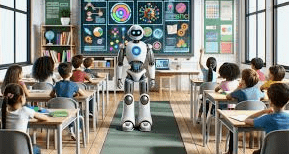By: Edward Worlanyo BANKAS
The education sector is experiencing unprecedented transformation as artificial intelligence tools rapidly enter classrooms worldwide.
From automated grading systems to personalized learning platforms and AI tutors, these technologies promise to revolutionize how students learn and teachers teach.
But a crucial question looms large: Are these intelligent systems enhancing teachers’ capabilities or gradually making human educators obsolete?
“Between 2021 and 2029, the global AI in education market is projected to reach $4.03 billion, growing at a CAGR of 45.12%.” – Technavio Research Report, 2023
This explosive growth of educational AI has triggered intense debate among educators, policymakers, parents and students about the future role of human teachers in an increasingly automated future learning environment.
How AI is Transforming Traditional Teaching Roles
The Administrative Burden Reduction
One of the most immediate benefits AI brings to education is the dramatic reduction in administrative workload that has traditionally consumed teachers’ time and energy.
“Teachers report spending an average of 31% of their work time on non-teaching administrative tasks. AI systems can potentially automate up to 20-40% of these routine responsibilities.” – McKinsey Global Institute, 2024
Grading multiple-choice assessments, tracking attendance, generating progress reports and organizing lesson materials are increasingly being delegated to AI systems. This automation theoretically frees teachers to focus on what many consider the core of their profession: meaningful interactions with students and creative instructional design.
Personalization at Scale
Traditional classrooms have always struggled with the inherent tension between standardized curriculum and the diverse learning needs of individual students.
“AI has recently introduced “teacherless classes” that will tailor the lessons to each student’s learning preferences and strengths. Benefits may include more personalized learning, accessibility and efficiency. Students can engage in this type of learning and then reflect on the similarities and differences to traditional teaching.’’- Daniel Niederjohn, PhD (American Psychological Association).
AI systems can now:
- Adjust difficulty levels based on individual student performance
- Recommend supplementary materials tailored to learning gaps
- Adapt presentation styles to match students’ learning preferences
- Provide immediate feedback without teacher intervention.
This level of personalization has traditionally been impossible for even the most dedicated teachers managing classrooms of 25-60 students.
Evidence of Teacher Empowerment
Despite fears of replacement, substantial evidence suggests that when implemented thoughtfully, AI tools will enhance rather than diminish the teacher’s role.
Amplifying Teacher Impact
“AI can save instructors massive amounts of time. AI enhances brainstorming, as it suggests approaches we might not otherwise have considered. If we already have elements of design we like, AI can help us reword, refine and format our designs in fancy tables to produce a polished finished product”- Laura Freberg, psychology at California Polytechnic State University.
Many educators using AI tools report feeling more effective and professionally satisfied when technological systems handle aspects of teaching that can be algorithmically optimized, allowing them to focus on the human elements that require emotional intelligence, ethical judgment and interpersonal skills.
Enhanced Professional Development
AI is also transforming how teachers learn and grow professionally.
“Incorporating AI into professional development for educators is a powerful way to enhance teaching strategies and streamline administrative tasks.
Educators can create more engaging and effective learning environments by building familiarity with AI tools, embracing pedagogical AI approaches and acquiring AI skills.”-Training Magazine, June 2024
From providing real-time feedback on instructional strategies to suggesting personalized growth opportunities based on classroom data, AI tools are helping teachers become more reflective and effective practitioners. “This clearly shows that educators who aren’t leveraging these AI tools might be missing out on their full potential and benefits.”
Warning Signs of Replacement
Despite these benefits, concerning trends suggest that in some contexts, AI may indeed be replacing rather than supporting human educators.
Cost-Driven Implementation
In resource-constrained educational environments, the economic calculus can favor replacing teachers with technology.
“47% of educational administrators in a global survey cited ‘cost reduction’ as a primary motivation for AI adoption, raising concerns about technology-driven staff reductions.” – Education International Survey, 2024
When financial considerations rather than pedagogical ones drive technology implementation, the risk of teacher displacement increases significantly.
Deskilling and Dependency
Some educators and researchers worry about the potential “deskilling” effect of over-reliance on AI systems.
“if AI systems are used to automate tasks traditionally performed by educators, there is a concern that this could undermine teachers’ professional expertise and reduce their role in the learning process.” – Taylor & Francis online, 2024
As teachers increasingly defer to algorithmic judgments about content sequencing, difficulty calibration and student assessment, they may gradually lose the professional skills and autonomy that define teaching as a profession.
The Missing Human Element
Perhaps most concerning are emerging studies suggesting that certain aspects of education suffer when human interaction is diminished.
“Students in heavily AI-mediated learning environments showed approximately 17% decrease in measures of intrinsic motivation compared to those in primarily teacher-led classrooms, despite similar or better academic outcomes.” – Journal of Educational Psychology, 2024
The relationship between teacher and student—characterized by mutual recognition, emotional resonance, and moral guidance—remains difficult to replicate in even the most sophisticated AI systems.
Finding the Balanced Path Forward
The evidence suggests neither a utopian future where AI perfectly complements human teachers nor a dystopian one where teachers are rendered obsolete. Instead, the impact of AI on teaching depends largely on implementation choices and educational priorities.
The Augmentation Model
The most promising approach appears to be an augmentation model, where AI handles tasks that can be efficiently automated while human teachers evolve into more specialized roles.
“Schools implementing ‘augmented teaching’ models, where AI handles content delivery and assessment while teachers focus on mentorship, project guidance, and social-emotional learning, report 32% higher student engagement and 28% higher teacher retention.” – Learning Policy Institute, 2024
In these settings, teachers become:
- Learning coaches and mentors
- Discussion facilitators and critical thinking guides
- Technology interpreters and ethical moderators
- Social-emotional development specialists
- Creative problem-solving instructors
Key Factors Determining Outcomes
Research suggests several factors significantly influence whether AI empowers or replaces teachers:
- Teacher involvement in technology selection and implementation
“A 2024 study by Stanford’s SCALE Initiative found that students using an AI-powered tutor learned more than twice as much in less time compared to those in active learning classes, also reporting higher engagement and motivation.’’ - Institutional values and priorities
“Districts with explicit commitments to maintaining or increasing human teaching staff while adopting AI tools showed no reduction in teaching positions, compared to an average 8% reduction in districts without such commitments.” – World Economic Forum & NEA. - Training and support for evolving teacher roles
“According to Carnegie Learning, teachers who use AI have found multiple benefits from doing so such as 42% found that using AI reduced the time spent on administrative tasks.”
The Road Ahead: Predictions and Recommendations
As AI becomes increasingly sophisticated, the education sector faces critical choices about preserving what’s best about human teaching while embracing technological benefits.
Likely Future Developments
Experts predict several trends in the coming years:
- AI for basic skills, humans for higher-order learning: AI handles rote tasks (e.g., math drills); teachers focus on critical thinking and creativity.
- Teacher training on human skills: Programs emphasize empathy, ethics-areas AI can’t replicate.
- Adaptive teacher-AI partnerships: Tech customizes teachers’ styles, enhancing workflows.
- More student/parent input: Families gain say in balancing AI and human instruction via feedback systems.
Recommendations for Education Stakeholders
To ensure AI empowers rather than replaces teachers, stakeholders should consider:
- For policymakers: Develop regulatory frameworks that prevent cost-driven replacement of qualified teachers with AI systems.
- For school leaders: Involve teachers meaningfully in all technology adoption decisions
- For teachers: Actively develop skills that complement rather than compete with AI capabilities.
- For teacher education programs: Prepare new teachers for collaborative work with AI tools while emphasizing uniquely human teaching competencies.
- For edtech developers: Design tools that enhance teacher capabilities and decision-making rather than bypassing or replacing them.
In summary: Enhance, Not Replace
The evidence suggests that the most productive question is not whether AI will replace teachers, but how to ensure it doesn’t.
When implemented with care and intention, AI tools can handle routine aspects of education while enabling educators to focus on the interpersonal, ethical and creative dimensions of learning that remain beyond the reach of algorithms.
The future of education isn’t about replacing teachers with AI, but about finding meaningful ways for both to work together. When human insight and artificial intelligence are combined, they can create richer, more personalized learning experiences than either could achieve alone.
Edward Worlanyo Bankas is a graduate of KNUST and an AI enthusiast, currently serving as an SEO & Content Marketing Specialist at Aya Data. His work focuses on search engine optimization and digital strategy, combining technical insight with creative execution to drive online growth.
Connect with Edward on LinkedIn or [email protected]










